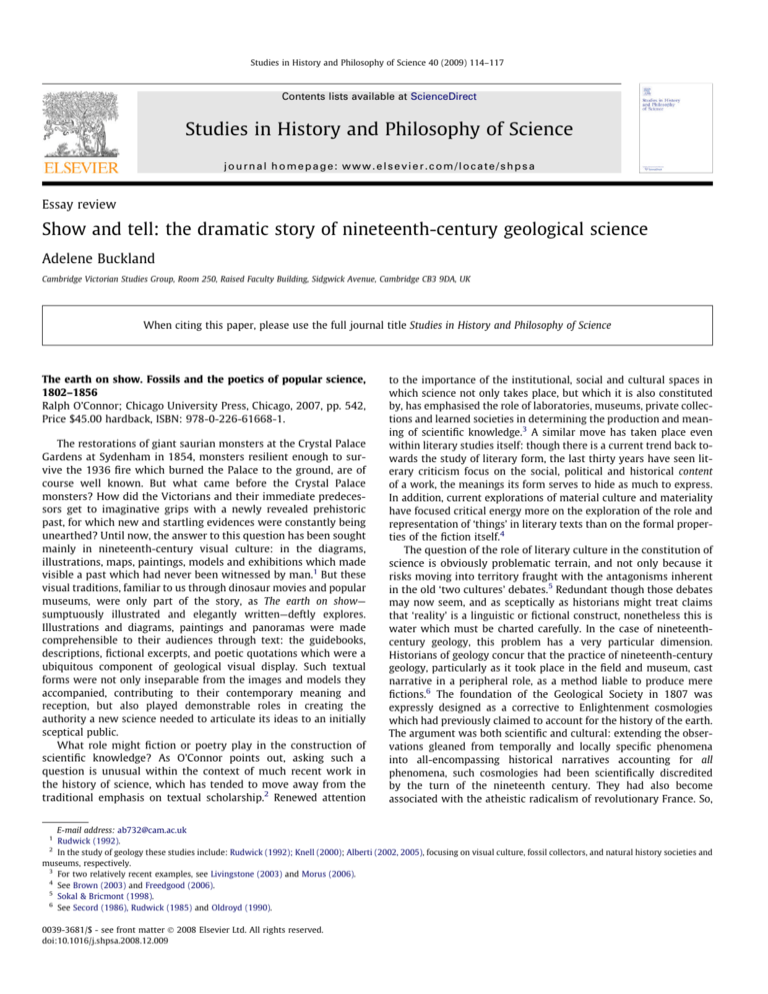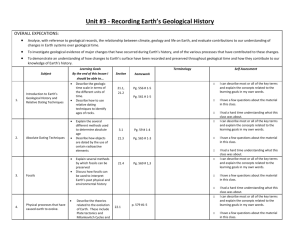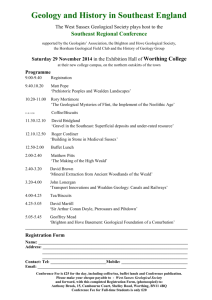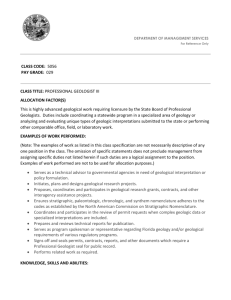
Studies in History and Philosophy of Science 40 (2009) 114–117
Contents lists available at ScienceDirect
Studies in History and Philosophy of Science
journal homepage: www.elsevier.com/locate/shpsa
Essay review
Show and tell: the dramatic story of nineteenth-century geological science
Adelene Buckland
Cambridge Victorian Studies Group, Room 250, Raised Faculty Building, Sidgwick Avenue, Cambridge CB3 9DA, UK
When citing this paper, please use the full journal title Studies in History and Philosophy of Science
The earth on show. Fossils and the poetics of popular science,
1802–1856
Ralph O’Connor; Chicago University Press, Chicago, 2007, pp. 542,
Price $45.00 hardback, ISBN: 978-0-226-61668-1.
The restorations of giant saurian monsters at the Crystal Palace
Gardens at Sydenham in 1854, monsters resilient enough to survive the 1936 fire which burned the Palace to the ground, are of
course well known. But what came before the Crystal Palace
monsters? How did the Victorians and their immediate predecessors get to imaginative grips with a newly revealed prehistoric
past, for which new and startling evidences were constantly being
unearthed? Until now, the answer to this question has been sought
mainly in nineteenth-century visual culture: in the diagrams,
illustrations, maps, paintings, models and exhibitions which made
visible a past which had never been witnessed by man.1 But these
visual traditions, familiar to us through dinosaur movies and popular
museums, were only part of the story, as The earth on show—
sumptuously illustrated and elegantly written—deftly explores.
Illustrations and diagrams, paintings and panoramas were made
comprehensible to their audiences through text: the guidebooks,
descriptions, fictional excerpts, and poetic quotations which were a
ubiquitous component of geological visual display. Such textual
forms were not only inseparable from the images and models they
accompanied, contributing to their contemporary meaning and
reception, but also played demonstrable roles in creating the
authority a new science needed to articulate its ideas to an initially
sceptical public.
What role might fiction or poetry play in the construction of
scientific knowledge? As O’Connor points out, asking such a
question is unusual within the context of much recent work in
the history of science, which has tended to move away from the
traditional emphasis on textual scholarship.2 Renewed attention
to the importance of the institutional, social and cultural spaces in
which science not only takes place, but which it is also constituted
by, has emphasised the role of laboratories, museums, private collections and learned societies in determining the production and meaning of scientific knowledge.3 A similar move has taken place even
within literary studies itself: though there is a current trend back towards the study of literary form, the last thirty years have seen literary criticism focus on the social, political and historical content
of a work, the meanings its form serves to hide as much to express.
In addition, current explorations of material culture and materiality
have focused critical energy more on the exploration of the role and
representation of ‘things’ in literary texts than on the formal properties of the fiction itself.4
The question of the role of literary culture in the constitution of
science is obviously problematic terrain, and not only because it
risks moving into territory fraught with the antagonisms inherent
in the old ‘two cultures’ debates.5 Redundant though those debates
may now seem, and as sceptically as historians might treat claims
that ‘reality’ is a linguistic or fictional construct, nonetheless this is
water which must be charted carefully. In the case of nineteenthcentury geology, this problem has a very particular dimension.
Historians of geology concur that the practice of nineteenth-century
geology, particularly as it took place in the field and museum, cast
narrative in a peripheral role, as a method liable to produce mere
fictions.6 The foundation of the Geological Society in 1807 was
expressly designed as a corrective to Enlightenment cosmologies
which had previously claimed to account for the history of the earth.
The argument was both scientific and cultural: extending the observations gleaned from temporally and locally specific phenomena
into all-encompassing historical narratives accounting for all
phenomena, such cosmologies had been scientifically discredited
by the turn of the nineteenth century. They had also become
associated with the atheistic radicalism of revolutionary France. So,
E-mail address: ab732@cam.ac.uk
Rudwick (1992).
2
In the study of geology these studies include: Rudwick (1992); Knell (2000); Alberti (2002, 2005), focusing on visual culture, fossil collectors, and natural history societies and
museums, respectively.
3
For two relatively recent examples, see Livingstone (2003) and Morus (2006).
4
See Brown (2003) and Freedgood (2006).
5
Sokal & Bricmont (1998).
6
See Secord (1986), Rudwick (1985) and Oldroyd (1990).
1
0039-3681/$ - see front matter Ó 2008 Elsevier Ltd. All rights reserved.
doi:10.1016/j.shpsa.2008.12.009
A. Buckland / Studies in History and Philosophy of Science 40 (2009) 114–117
repeatedly disparaging the narrative reconstruction of the past as an
activity tending to produce speculative, effeminate, and dangerous
fictions, founder members of the Geological Society of London eschewed theoretical conjecture in favour of a rigorously empirical
study of geological ‘facts’. This methodological premise yielded startling results, and consequently it long outlasted fears of revolution,
becoming integral to the practice of the new science itself: by the
1830s geologists were far more concerned with determining the order and structure of the strata, and with producing geological maps,
than they were with telling the story of earth history.
Focusing quite radically, then, on the geological story of earth
history as it was constructed between 1802 and 1856 O’Connor argues that, if the gentlemen of the Geological Society did not write
narratives of earth history, this was largely determined by their
necessarily cautious approach to the public mood. As the century
wore on, however, narrative histories of the earth’s past grew in
confidence, stature, and public appeal. They moved out of the
private arenas of the dinner club or the university lecture and into
the public domain of exhibitions and geological works intended for
the general reader. Shifting the sources of historical inquiry from
geological practice onto geological texts, O’Connor considerably
reworks received literature on this subject, telling the tale of a
growing range of outlets for a storytelling geological imagination.
By the 1840s and 1850s competing versions of earth history positively battled it out in the literary marketplace, fighting to tell the
most consummate story and to best capture their readers’
imaginations.
O’Connor’s textual approach to the study of earth history far
transcends conventional historical methods. For one thing, he does
not abandon attention to the institutional and cultural spaces in
which scientific knowledge was produced in the nineteenth
century: museums, exhibitions, paintings and panoramas figure
prominently in his discussion. More importantly, he lingers long
and fruitfully on unconventional and ephemeral texts and textual
moments: on the beginnings and endings of chapters in geological
textbooks, on guidebooks, on poetic quotations as they were situated alongside visual displays, on unpublished geological verses,
on annotations and broadsheets. The story of earth history
tentatively took hold in the relatively ephemeral textual spaces
of the frontispiece, or the thumbnail sketch of the antediluvian
past. Such sketches often took the form of brief snapshots in much
larger works, offering an only temporary imaginative respite from
painstaking description and analysis. In Buckland’s Geology and
mineralogy verbal restorations of earth history are largely pictorial,
for example, their overarching narratives left implicit, to be
inferred by readers rather than revealed to them. Similarly, writers
often exhibited self-consciousness about the movement from technical exposition to the restoration of scenes from deep time,
demarcating the transition through typography or abrupt shifts
in prose style. The ephemerality of such writings contributes to
the exciting texture of O’Connor’s historical reconstruction of the
shaping up of the story of earth history in this period, and it bears
an elegant resemblance to the nature of nineteenth-century
geological research, reassembling creatures and worlds from tiny
fragments. Poking into the recesses of the written geological
imagination, in the textual interstices between visual and material
representations of earth history, this book breaks into new territory as a methodology through which to think about the histories
of science and of literary culture. Indeed, as O’Connor argues
throughout, the appellation ‘science and literature’ fails in its
ostensible aim to disrupt the disciplinary separation of knowledge
or of modes of knowing. The approach here is to see geological
writing as an intrinsic part of literary culture. Less science and
literature, for O’Connor science is literature.
It is possible to put forward a range of counter-arguments and
caveats which are worthy of consideration on this subject. Are all
115
scientific modes of writing equally contributory to the literary culture of any given period? Is nineteenth-century geology, racked
with epistemological problems about the role of narrative in
reconstructing the past, and seeking to imaginatively reconstruct
landscapes and creatures for whom much of the available evidence had been lost, simply a special case? Or, is there a distinction to be made between modes of writing which share genres, or
which share content, and those which can be considered to be of
the same disciplinary formation? But to suggest that the problem
requires careful thought is not to detract from the power this approach has for O’Connor’s work. The literary nature of Victorian
geological science, particularly in its interpenetration with the visual and material cultures of display and reconstruction, is nowhere clearer than in his opening discussion of the mammoth
reconstructions at Pall Mall and the Egyptian Temple in the earliest years of the century, for example. The rhetoric of the spectacular in the guidebooks to these exhibits directly influenced William
Buckland’s verbal restorations of earth history in his Oxford University lectures of the 1820s and 1830s. In turn, the geological
verses penned by the students and dons who attended Buckland’s
lectures, circulated in manuscript or in privately printed broadsheets, represent the first, still-tentative efforts to tell the story
of earth history. Rarely straying outside the milieu of the genteel
these verses functioned as a comic vein through which daring scenarios could be tested without the need for public commitment.
And, though they were circulated within and produced by a relatively small group of readers, Buckland’s important position within the university as a bastion of Anglican learning meant that his
dramatic restorations of former worlds, and his images of geologist as necromancer, time-travelling guide, and visionary dreamer
became central to geology’s more public articulation in the 1830s
and beyond.
Not only was the literary culture of geology vital within the
institutions and cultural spaces in which knowledge was produced
and displayed—the lecture hall, the exhibition space, or the university. Geological guidebooks, lectures, descriptions and poems were
an important and neglected stream within nineteenth-century literary culture itself. Exploring the controversy surrounding Byron’s
verse-drama Cain: A mystery, a biblical ‘problem play’ asking how
Cain came to kill Abel, O’Connor explains that Lucifer’s temptation
of Cain involved the teaching of an ancient earth through a cosmic
voyage into deep time, populated with extinct pre-Adamites,
mammoths and leviathans. The explicitly Cuverian geology
embodied in Lucifer’s teaching meant that some commentators
saw it as an unwelcome form of geological popularisation, and
Buckland saw the text as enough of a threat to his positioning of
geology within Anglican learning to write a satirical verse ‘antidote’ to Byron’s play, The professor’s descent (1822). Nonetheless,
by 1836 Buckland’s friends and colleagues George Poulett Scrope
and William Broderip used Cain to puff his Geology and mineralogy
(1836) in the Quarterly Review, casting Buckland as Lucifer in order
to generate a frisson around the text. Later, O’Connor argues that
Cain was in Gideon Mantell’s mind as he wrote the ‘retrospect’
envisioning the colossal forms of a dim and distant landscape in
his widely selling The medals of creation (1844). Biblical stories,
epic poetry, and the writings of Buckland, Cain, Scrope, Broderip,
Cuvier, interweave here to the point of indissolubility. Geological
writings constitute a powerful imaginative strand within the nineteenth-century imagination, and fiction was a vital mode through
which earth history could be given shape. The phrase ‘literature
and science’ cannot apply here.
This productive collapse of disciplinary boundaries extends into
the very texture of O’Connor’s argument. Not only does The earth
on show make an important contribution to the current rise in
interdisciplinary or multidisciplinary studies, and to discussions
of the best ways in which to write histories free from the
116
A. Buckland / Studies in History and Philosophy of Science 40 (2009) 114–117
encumbrances of modern disciplinary formations. It is also richly
attentive to the construction of disciplinary and denominational
divisions within the nineteenth century itself. In part this is
achieved by a focus on what O’Connor calls ‘popular’ science. By
this he means any attempt to reach a wider public than had
hitherto been usual. This definition of ‘popular’ science is far
broader than that recently given by Bernard Lightman, who excludes instrument makers, museum curators, and showmen and
women from the business of science proper, and institutes a clear
dividing line between ‘popularizers’ and ‘practitioners’. Refusing to
make such distinctions, O’Connor is enabled to talk about the place
of narrative in a science which defined itself in opposition to storytelling, and about the role of texts within a historiography which
has hitherto focused more squarely on geological practice. But
more importantly he is also enabled to do justice to the sheer multiplicity of intellectual positions occupied by writers from across a
spectrum of ideological, disciplinary, and denominational positions. For instance, as more English fossil vertebrates were identified in the 1820s geological writers garnered an increasing selfconfidence. Such writers included not only the ‘old-earth’ geologists but Biblical literalists, whose contributions to the debate are
not derided here, but are explored as so imaginatively powerful
that old-earth geologists, including Charles Lyell, were spurred
on to step up their publicity. O’Connor demonstrates that Lyell
and the literalists both drew on the same showmanlike, epic and
apocalyptic rhetoric. Moreover, the literalists themselves are revealed in much of their heterogeneity: far from represented as a
single group of backwards-looking, antiscientific reactionaries, as
much of the literature has had them, here they are shown to make
a wide range of different arguments about the meaning and status
of geological science. Many ‘literalists’ supported the old-earth
geology. In this light literalist interpretations of the Bible emerge
neither as inherently oppositional, nor as merely peripheral, to
the ‘real’ business of geological science, but as a central discourse
through which it gained access to the public stage.
If there is a point of difficulty in the arguments offered by The
earth on show these are little more than an outcome of its illuminating and successful intervention in the subjects and methods
of the historical study of the sciences, its fruitful destabilisation
of the boundaries between modes of writing and between scientific
practices. In shifting attention from the visual iconography of geology, from the projects of mapping and stratigraphy which have
hitherto been seen to dominate the science, and from the powerhouse of geological thought, the Geological Society, O’Connor
opens up new ways of thinking about earth science and its cultural
significance. But his attention to textual fragments and to marginalised historical voices (including poets, guidebook writers and
literalists) occasionally threatens imbalance. O’Connor points out
that his story of augmenting nineteenth-century confidence in
the geological story is reliant on relatively tiny textual reconstructions which threaten to be overwhelmed by the much greater body
of technical and descriptive prose pouring out of the nineteenthcentury presses. And he has a sharp sense of narrative as a problematic concern for would-be geological storytellers, frequently referring to the uneasiness with which narratives of earth science
continued to be articulated by nineteenth-century writers even
into the 1850s. But the problematic nature of stories of earth history often gets lost in the exuberance with which he treats his
material. This issue is clear in his negotiation of the tensions that
exist between pictorial and narrative modes of representation.
On one level, poetic and visual boundaries were often collapsed
in nineteenth-century theatrical presentations of other landscapes
and times, as this book explores in profuse detail. But the nature of
these moments of collapse, and the precise manner in which they
negotiated representational difficulties, are of interest in the case
of the contested narrative representation of the earth’s past. O’Con-
nor uses David Ansted’s The ancient world, partly written to refute
evolutionary romances like Vestiges, as an argument both for the
narrative composition of even anti-evolutionary texts and for their
theatricality: ‘Like Vestiges’, he writes, ‘its geological narrative
mainly comprises descriptions of fossil evidence rather than lively
restorations, but there are enough of the latter sprinkled around to
sustain the impression of ‘‘picturesque sketches”. Cautious as
Ansted was, theatrical analogies lurk in the background’. Theatricality does not necessarily entail narrative: indeed, such Victorian
theatrical forms as melodrama often presented a series of largely
discontinuous scenes only loosely connected by a narrative thread,
or not connected in narrative sequences at all. Ansted’s ‘picturesque sketches’ are equally likely to be produced by an author wary
of making the kinds of narrative connections between scenes that
were being made by the authors of transmutationist theories as
they are to be considered rival narratives in their own right. Again,
O’Connor strains to describe Miller’s simultaneously ‘theatrical’
and ‘storytelling’ imagination but does not explore in depth the
tensions between those two terms—his means of reconciling them
without further comment is simply to suggest that Miller was
accustomed ‘to reading plays rather than watching them’
(p. 398). In more general terms, the occasional slippages which
exist in O’Connor’s writing between theatre, spectacle and story
suggest the dangers which lurk behind his methodology: though
his deconstruction of the boundaries between ‘literature’ and
‘science’, or between and within different groups of geological
writers, is the basis of this book’s powerful contribution to
nineteenth-century intellectual history, it is important to remember (as O’Connor almost always does) that sometimes the differences between genres, disciplines, and historical actors are as
important as their similarities.
Nonetheless, the conjunction of the spectacular, the poetic, and
the fictional here brings into sharp relief the genuine hybridity of
Victorian literary culture. Within the context of the commercialisation of museums after the 1830s, the growth of the literary and
philosophical societies, and the expansion of print culture, the road
was paved for a geological vein of writing characterised (much like,
though O’Connor does not note this, the novelistic productions of
these years) by ‘generic plurality’ (p. 229). Travel writing, natural
history compendia, antiquarian works, biblical scholarship, adventure stories, autobiographical accounts, didactic literature, the
‘conversations’ genre, apocalyptic spectacle, and natural theology
treatises shaped the writing of this new earth history with increasing elaboration, and such writings exhibited increasing confidence
to allude to Byron, Milton and Dante, and legends, romances, novels and epic poems. On occasion this hybrid geological mode even
prompted original verse-creations by those seeking to verbally
restore former worlds to the human imagination. In the final
chapter the geologist and journalist Hugh Miller is considered as
an exemplar of this hybrid geological writing, stylistically and
structurally reproducing dioramic and panoramic modes of
envisioning the world, complete with stage directions and
imaginary voyages into the past. Rich in Miltonic undercurrents,
Miller’s prose is used to enrich rather than eclipse the Biblical
narrative just as Milton himself had done. As such, Miller’s timetravelling forays into prehistory were epics for the industrial age,
and they function for O’Connor as emblematic writings in a
powerful imaginative tradition which reaches from the nineteenth
century to the present.
In this respect, as well as in its close attention to marketing and
publishing strategies, to traditions of science writing, and to an
unstable literary market, this book shares much with James A.
Secord’s Victorian sensation (2000). Furthermore, despite its focus
on textual culture, it continues to owe a debt to Rudwick’s work
on geological visual culture, and particularly to the study of
Victorian spectacle in Richard Altick’s seminal work The shows of
A. Buckland / Studies in History and Philosophy of Science 40 (2009) 114–117
London (1978).7 Provocatively examining a genuinely hybrid
cultural mode, the nineteenth-century geological imaginary, The
earth on show takes an ambitious and original approach to the
methodological problems facing critics and cultural historians who
wish to talk about science. Its evocation of the interpenetration of
visual and verbal scientific modes intelligently dispenses with much
of the disciplinary and critical paraphernalia which often hampers
writings on this subject. Moreover, the density of its research and
the persuasiveness of its fruitful readings of a broad range of texts
and spectacles mean that, like the works of Altick, Rudwick and
Secord, this book is likely to form the basis of a host of further
studies. As O’Connor points out, his book provides groundwork for
studies of the reception of geological verse or spectacle, or of the role
of other literary genres such as the novel, in the development of the
modern geological imagination. That it is so richly suggestive of
further avenues can only be taken as a sign of the vibrancy of its
approach to the idea of fiction in the scientific imagination, and
the importance of its contribution to scholarly studies in that area.
References
Alberti, S. J. M. M. (2005). Objects and the museum. Isis, 96, 559–571.
Alberti, S. J. M. M. (2002). Placing nature: Natural history collections and their
owners in nineteenth-century provincial England. British Journal for the History
of Science, 35, 291–311.
7
Altick (1978).
117
Altick, R. (1978). The shows of London. Cambridge, MA: Belknap Press.
Brown, B. (2003). A sense of things: The object matter of American literature. Chicago:
University of Chicago Press.
Freedgood, E. (2006). The ideas in things: Fugitive meaning in the Victorian novel.
Chicago: University of Chicago Press.
Knell, S. J. (2000). The culture of English geology, 1815–51: A science revealed through
its collecting. Aldershot: Ashgate.
Livingstone, D. (2003). Putting science in its place. Chicago: University of Chicago
Press.
Mantell, G. A. (1844). The medals of creation: Or, first lessons in geology, and in the
study of organic remains (2 vols.). London: Bohn.
Morus, I. (2006). Replacing Victoria’s scientific culture. 19: Interdisciplinary Studies in
the
Long
Nineteenth
Century,
2.
http://www.19.bbk.ac.uk/issue2/
ReplacingVictoria.pdf.
Oldroyd, D. R. (1990). The highlands controversy: Constructing geological knowledge
through fieldwork in nineteenth-century Britain. Chicago: University of Chicago
Press.
Rudwick, M. (1992). Scenes from deep time: Early pictorial representations of the
prehistoric world. Chicago: University of Chicago Press.
Rudwick, M. (1985). The great Devonian controversy: The shaping of scientific
knowledge among gentlemanly specialists. Chicago: University of Chicago Press.
Secord, J. A. (1986). Controversy in Victorian geology: The Cambrian–Silurian dispute.
Princeton: Princeton University Press.
Secord, J. A. (2000). Victorian sensation: The extraordinary publication, reception, and
secret authorship of Vestiges of the Natural History of Creation. Chicago: University
of Chicago Press.
Sokal, A. D., & Bricmont, J. (1998). Intellectual impostures: Postmodern philosophers’
abuse of science. London: Profile.






